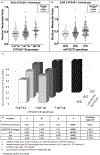Accuracy and applications of sequencing and genotyping approaches for CYP2A6 and homologous genes
- PMID: 35190513
- PMCID: PMC9081136
- DOI: 10.1097/FPC.0000000000000466
Accuracy and applications of sequencing and genotyping approaches for CYP2A6 and homologous genes
Abstract
Objectives: We evaluated multiple genotyping/sequencing approaches in a homologous region of chromosome 19, and investigated associations of two common 3'-UTR CYP2A6 variants with activity in vivo.
Methods: Individuals (n = 1704) of European and African ancestry were phenotyped for the nicotine metabolite ratio (NMR), an index of CYP2A6 activity, and genotyped/sequenced using deep amplicon exon sequencing, SNP array, genotype imputation and targeted capture sequencing. Amplicon exon sequencing was the gold standard to which other methods were compared within-individual for CYP2A6, CYP2A7, CYP2A13, and CYP2B6 exons to identify highly discordant positions. Linear regression models evaluated the association of CYP2A6*1B and rs8192733 genotypes (coded additively) with logNMR.
Results: All approaches were ≤2.6% discordant with the gold standard; discordant calls were concentrated at few positions. Fifteen positions were discordant in >10% of individuals, with 12 appearing in regions of high identity between homologous genes (e.g. CYP2A6 and CYP2A7). For six, allele frequencies in our study and online databases were discrepant, suggesting errors in online sources. In the European-ancestry group (n = 935), CYP2A6*1B and rs8192733 were associated with logNMR (P < 0.001). A combined model found main effects of both variants on increasing logNMR. Similar trends were found in those of African ancestry (n = 506).
Conclusion: Multiple genotyping/sequencing approaches used in this chromosome 19 region contain genotyping/sequencing errors, as do online databases. Gene-specific primers and SNP array probes must consider gene homology; short-read sequencing of related genes in a single reaction should be avoided. Using improved sequencing approaches, we characterized two gain-of-function 3'-UTR variants, including the relatively understudied rs8192733.
Copyright © 2022 Wolters Kluwer Health, Inc. All rights reserved.
Conflict of interest statement
Conflicts of Interest: RF Tyndale has consulted for Quinn Emanuel and Ethismos Research Inc; all other authors declared no conflict of interest.
Figures






References
-
- Lung Cancer Fact Sheet | American Lung Association. 2019; Available from: https://www.lung.org/lung-health-and-diseases/lung-disease-lookup/lung-c....
-
- Tobacco. 2019; Available from: https://www.who.int/news-room/fact-sheets/detail/tobacco.
-
- Benowitz NL, Clinical pharmacology of nicotine: implications for understanding, preventing, and treating tobacco addiction. Clin Pharmacol Ther, 2008. 83(4): p. 531–41. - PubMed
-
- Nakajima M, et al., Role of human cytochrome P4502A6 in C-oxidation of nicotine. Drug Metab Dispos, 1996. 24(11): p. 1212–7. - PubMed
-
- Dempsey D, et al., Nicotine metabolite ratio as an index of cytochrome P450 2A6 metabolic activity. Clin Pharmacol Ther, 2004. 76(1): p. 64–72. - PubMed
Publication types
MeSH terms
Substances
Grants and funding
LinkOut - more resources
Full Text Sources

